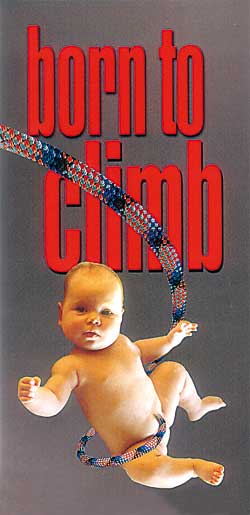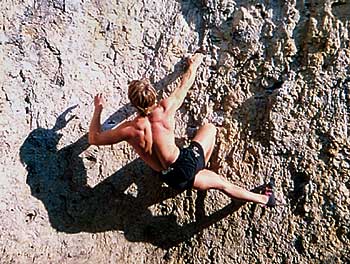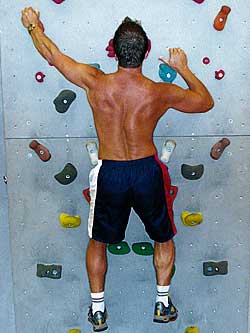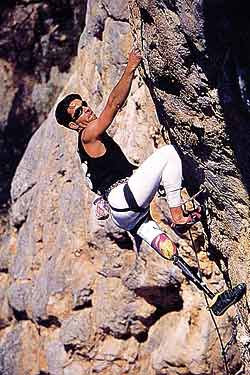



|
|
From the development of artificial climbing walls to its establishment as a competitive sport, modern climbing has gained new interest in the public eye. The fundamentals of climbing, that is certain essential elements of this sport, are also valid concepts in an orthopaedic-traumatological clinical context, for the treatment of chronic–degenerative and, particularly, neurological diseases
THERAPUTIC CLIMBING
Marco Brazzo
All different species existing in nature move thanks to a locomotive apparatus, which, through time, has been perfectly adapted to environmental demands. We may view this apparatus as a lever system, where muscles represent the force, bone segments form the resistance, and joints the fulcrums. Physics tells us that there are three types of levers: advantageous, disadvantageous and neutral.
The levers man is equipped with are advantageous only for climbing, just as those of horses are advantageous only for galloping, those of birds for flying and those of fish for swimming. In other words, the locomotive apparati of all living species on Earth has become ideal for the expression only one type of movement, dictated the way in which they function. Unfortunately, man has created, in only a short time (short in relation to the adaptive periods for living species, which cover millions of years) an environment hostile to his physiology, significantly different from the one he was placed in by his Creator. Seats, tables, cars, computers, lecterns, musical instruments, artificial light etc, are components of a “gymnasium” forcing man into unnatural and damaging everyday “training” of his muscular-skeletal apparatus.
Sensing the risks this sedentary lifestyle places on his physical health, man resorts to sporting activities, without considering the permanent damage this does to his body. There is indeed no sport that allows human levers to express the type of movement they were originally created for. The aim of sports is not to achieve good health, but to learn a technique of movement in order to achieve a result. Nature was in no position to foresee that Tom would play tennis, or that Dick would be a swimmer, creating different locomotive apparati for each man and even catering for “interchangeable” muscular-skeletal levers, in case Tom and Dick decided to switch sports!
Climbing, and movement whilst hanging, are indispensable in motor development and the achievement of the erect human position.
This motor activity represents an introductory training program for closed kinetic chains. From a physiotherapeutic perspective, climbing offers positive stimulus for applying adequate force to the locomotive apparatus (closed biomechanical systems).
Modern sports training represent the basis of this new therapeutic concept. Thanks to easily installed artificial climbing walls of limited dimensions, in a variety of designs and inclinations, therapeutic climbing has become an accessible and practicable option in all physiotherapeutic and kinesiology labs.
This motor activity also offers important neurophysiological and motivational therapeutic stimuli for the treatment of: neuromuscular and orthopaedic (joint and vertebral traumas, scoliosis) and neurological dysfunctions (multiple sclerosis, paresis etc).
Education in this therapeutic technique is based on strong knowledge of Functional Anatomy, Kinetics and Neuromuscular Rehabilitation and uses video documentaries of case studies and practical exercises with patients.
dott. Marco Brazzo, Kinesiologist, Osteopath
www.marcobrazzo.it |
